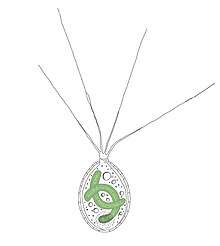Paulinella
Paulinella is a genus of about nine[6] species of freshwater amoeboids.
| Paulinella | |
|---|---|
 | |
| Scientific classification | |
| Clade: | SAR |
| Phylum: | Cercozoa |
| Class: | Imbricatea |
| Order: | Euglyphida |
| Family: | Paulinellidae |
| Genus: | Paulinella Lauterborn[1] |
| Species | |
| |
Its most famous members are the three photosynthetic species P. chromatophora, P. micropora and P. longichromatophora, the first two being freshwater forms and the third a marine form,[7] which has recently (in evolutionary terms) taken on a cyanobacterium as an endosymbiont.[8] The plastid is often referred to as the 'cyanelle' or chromatophore. The endosymbiotic event happened about 90–140 million years ago in a bacterial species which diverged about 500 million years ago from some known cyanobacteria.[9][10] This is striking because the chloroplasts of all other known photosynthetic eukaryotes derive ultimately from a single cyanobacterium endosymbiont, which was taken in probably over a billion years ago by an ancestral archaeplastidan (and subsequently adopted into other eukaryote groups, by further endosymbiosis events). The P. chromatophora symbiont was related to the Prochlorococcus and Synechococcus cyanobacteria (sister to the group consisting of the living members of those two genera).[3] The chromatophore genome has gone through a reduction, and is now just one third the size of the genome of its closest free living relatives, but still 10-fold larger than most plastid genomes. Some of the genes have been lost, others have migrated to the amoeba's nucleus through endosymbiotic gene transfer.[11] Other genes have degenerated due to Muller's ratchet - accumulations of harmful mutations due to genetic isolation, and have probably been replaced with genes from other microbes through horizontal gene transfer.[12] The nuclear genes of P. chromatophora (those regions not modified by the symbiont) are most closely related to the heterotrophic P. ovalis.[13] P. ovalis also have at least two cyanobacterial-like genes, which were probably integrated into their genome through horizontal gene transfer from its cyanobacterial prey. Similar genes could have made the photosynthetic species pre-equipped to accept the chromatophore.[14]
References
- M.D. Guiry in Guiry, M.D. & Guiry, G.M. 2013. AlgaeBase. World-wide electronic publication, National University of Ireland, Galway. http://www.algaebase.org; searched on 4 March 2013.
- "Paulinella". Integrated Taxonomic Information System. Retrieved 28 January 2008.
- Birger Marin, Eva CM Nowack, Gernot Glöckner, and Michael Melkonian (2007). "The ancestor of the Paulinella chromatophore obtained a carboxysomal operon by horizontal gene transfer from a Nitrococcus-like γ-proteobacterium". BMC Evol. Biol. 7: 85. doi:10.1186/1471-2148-7-85. PMC 1904183. PMID 17550603.CS1 maint: multiple names: authors list (link)
- "Paulinella" (HTML). NCBI taxonomy. Bethesda, MD: National Center for Biotechnology Information. Retrieved 4 January 2019.
Lineage(full) cellular organisms; Eukaryota; Rhizaria; Cercozoa; Imbricatea; Silicofilosea; Euglyphida; Paulinellidae
- "Paulinella ovalis". Retrieved 31 January 2008.
- "Eukaryotes". Retrieved 28 January 2008.
- Evolutionary dynamics of the chromatophore genome in three photosynthetic Paulinella species - Nature
- Laura Wegener Parfrey; Erika Barbero; Elyse Lasser; Micah Dunthorn; Debashish Bhattacharya; David J Patterson & Laura A Katz (December 2006). "Evaluating Support for the Current Classification of Eukaryotic Diversity". PLoS Genet. 2 (12): e220. doi:10.1371/journal.pgen.0020220. PMC 1713255. PMID 17194223.
- Sánchez-Baracaldo, Patricia; Raven, John A.; Pisani, Davide; Knoll, Andrew H. (12 September 2017). "Early photosynthetic eukaryotes inhabited low-salinity habitats". Proceedings of the National Academy of Sciences. 114 (37): E7737–E7745. doi:10.1073/pnas.1620089114. ISSN 0027-8424. PMC 5603991. PMID 28808007.
- Pérez-Zamorano, Bernardo; Valadez-Cano, Cecilio; Delaye, Luis (15 March 2016). "How Really Ancient Is Paulinella Chromatophora?" Check
|url=value (help). PLOS Currents Tree of Life. 8. doi:10.1371/currents.tol.e68a099364bb1a1e129a17b4e06b0c6b. PMC 4866557. PMID 28515968. Retrieved 4 April 2019 – via currents.plos.org. - Zhang, Ru; Nowack, Eva C. M.; Price, Dana C.; Bhattacharya, Debashish; Grossman, Arthur R. (1 April 2017). "Impact of light intensity and quality on chromatophore and nuclear gene expression in Paulinella chromatophora, an amoeba with nascent photosynthetic organelles". The Plant Journal: For Cell and Molecular Biology. 90 (2): 221–234. doi:10.1111/tpj.13488. PMID 28182317.
- This little amoeba committed grand theft: Scientists reveal how a little-known amoeba engulfed a bacterium to become photosynthetic
- Patrick J. Keeling (2004). "Diversity and evolutionary history of plastids and their hosts". American Journal of Botany. 91 (10): 1481–1493. doi:10.3732/ajb.91.10.1481. PMID 21652304.
- Steal My Sunshine | The Scientist Magazine